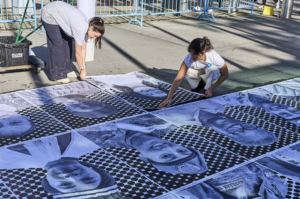Why Are Women Experts Still Excluded From Peace Talks Across the Globe?
This article was originally published by PassBlue, a women-led nonprofit newsroom that covers the U.N. and global women’s rights.
Every year, women’s equal roles in peace talks are highlighted in October at the United Nations. This time, the women, peace and security agenda, as it’s known, got attention outside the U.N., near the steps to its main entrance on First Avenue and 47th Street, in east midtown Manhattan. There, advocates who persevere for women’s full participation in the herculean efforts to build peace from the ground up in wars and other troubled parts of the world took their message to the sidewalk.
“Amazing women all over the world, in all different contexts, are risking their lives, sometimes sacrificing their lives, to prevent conflicts from breaking out,” said Natasha Lamoreaux, a coordination specialist for U.N. Women, at the interactive, day-long event on Oct. 25. “They really understand and feel deeply the consequences of war, but they’re not invited to the peace table.
“And without them,” she added, “a sustainable and durable peace is just not possible.”
U.N. Women, the organization’s entity solely focused on gender equality and the empowerment of women globally, hosted the awareness-raising event with the U.N. Department of Peace Operations, the Department of Political and Peacebuilding Affairs and the Elsie Initiative Fund for Uniformed Women in Peace Operations, a U.N. program.
Under generous fall sunshine, the event featured a display of 50 life-size black and white portraits, set against polka-dotted backgrounds, of women peace-builders and peacekeepers from around the globe. In partnership with the Inside Out Project, a public art initiative founded by the French artist JR, and its monthlong campaign, “Peace Begins With Her,” the portraits were pasted to the sidewalk near the U.N.’s front door—a prime real estate spot full of people waiting to enter the U.N. for its regular tours and a steady stream of delegates walking into the compound, too.
The images of the women on display were meant to send a powerful reminder to world leaders and their delegations—some of them sitting in the conference rooms and chambers inside the U.N. each workday—and the public about the urgent need to have women involved at the highest levels of peacemaking and peace-building processes, no matter the size or shakiness of the proverbial negotiating table. And regardless of how many men with or without guns dominate the proceedings.
“When it comes to who’s invited to the table, we hear time and time again, from the, you know, ‘the people in charge’ that they couldn’t find qualified women,” Lamoreux said as she pointed at the portraits displayed at Wednesday’s exhibition. She continued: “We’ve got 50 women right here. We’ve got 50 ideas for how we can prevent conflict, resolve conflict and rebuild communities.”
The event also included a mobile photo booth, where people could have their picture taken as a gesture of support for world peace and gender equality.
In addition to coinciding with the annual Security Council debate being held on Oct. 25, marking the commemoration of Resolution 1325—adopted on Oct. 31, 2000—to address “the impact of war on women and the importance of women’s full and equal participation in conflict resolution, peacebuilding, peacekeeping, humanitarian response and in post-conflict reconstruction,” the exhibition also lined up with the release of Secretary-General António Guterres’s yearly report on women, peace and security.
Its grim findings show why women are needed now more than ever to play equal roles carrying out peace initiatives. “The number of women and girls living in conflict-affected countries reached 614 million in 2022, 50 percent higher than the number in 2017,” the report said. “Much of this increase is driven by nearly 200 armed conflicts and situations of organized violence, as well as by the climate crisis and the impact of the coronavirus disease (COVID-19).” In 2022 alone, countries increased their military spending to $2.2 trillion as global humanitarian emergencies keep rising.
Guterres himself said at the Security Council debate, which lasted through the next day: “Despite our best efforts, women represented just sixteen percent of negotiators or delegates in the peace processes led, or co-led, by the United Nations. Women have had enough of being shut out of the decisions that shape their lives. … No more stalling, no more coasting, no more delays. We need to back the change-makers whose images we proudly display outside this building, starting today. The state of the world demands it. And women and girls, rightly, expect nothing less.”
The reality is that women remain sidelined from primary peace talks. While women participated in 80 percent of U.N.-led or co-led processes, they represent only about 16 percent of total participants, a rate that has dropped two years in a row.
